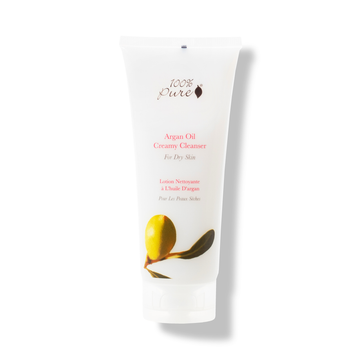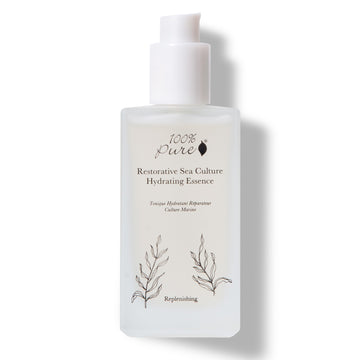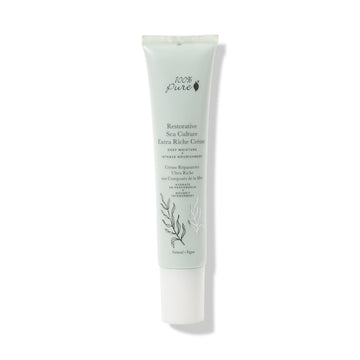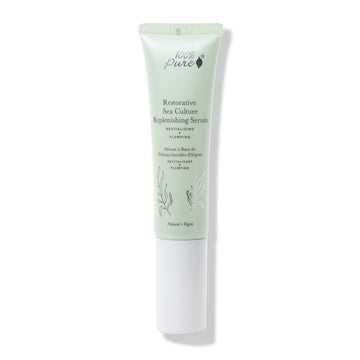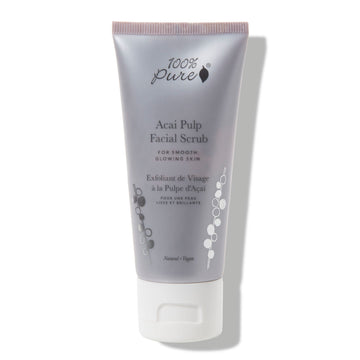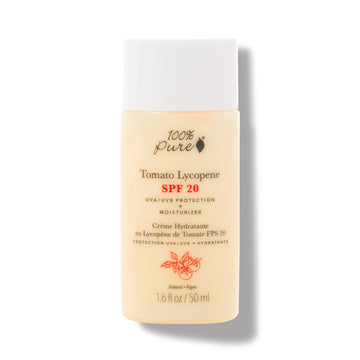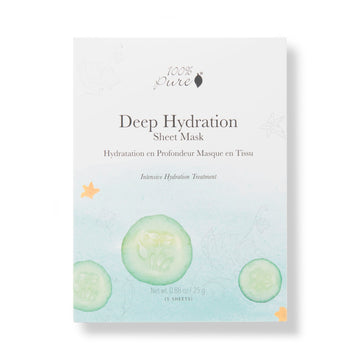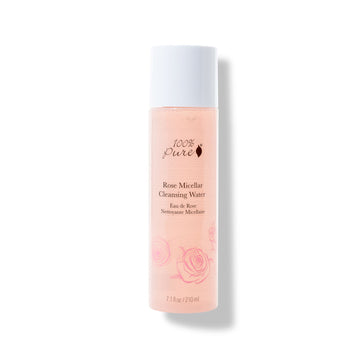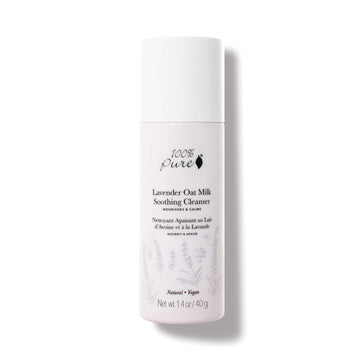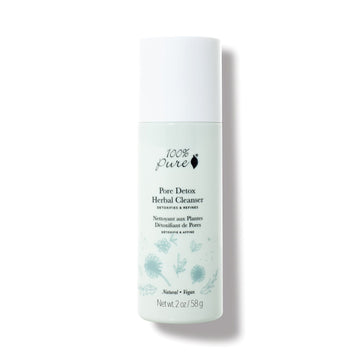Seasonal exfoliating, do’s and don’ts, and exfoliating for your skin type
Written by: 100% PURE ®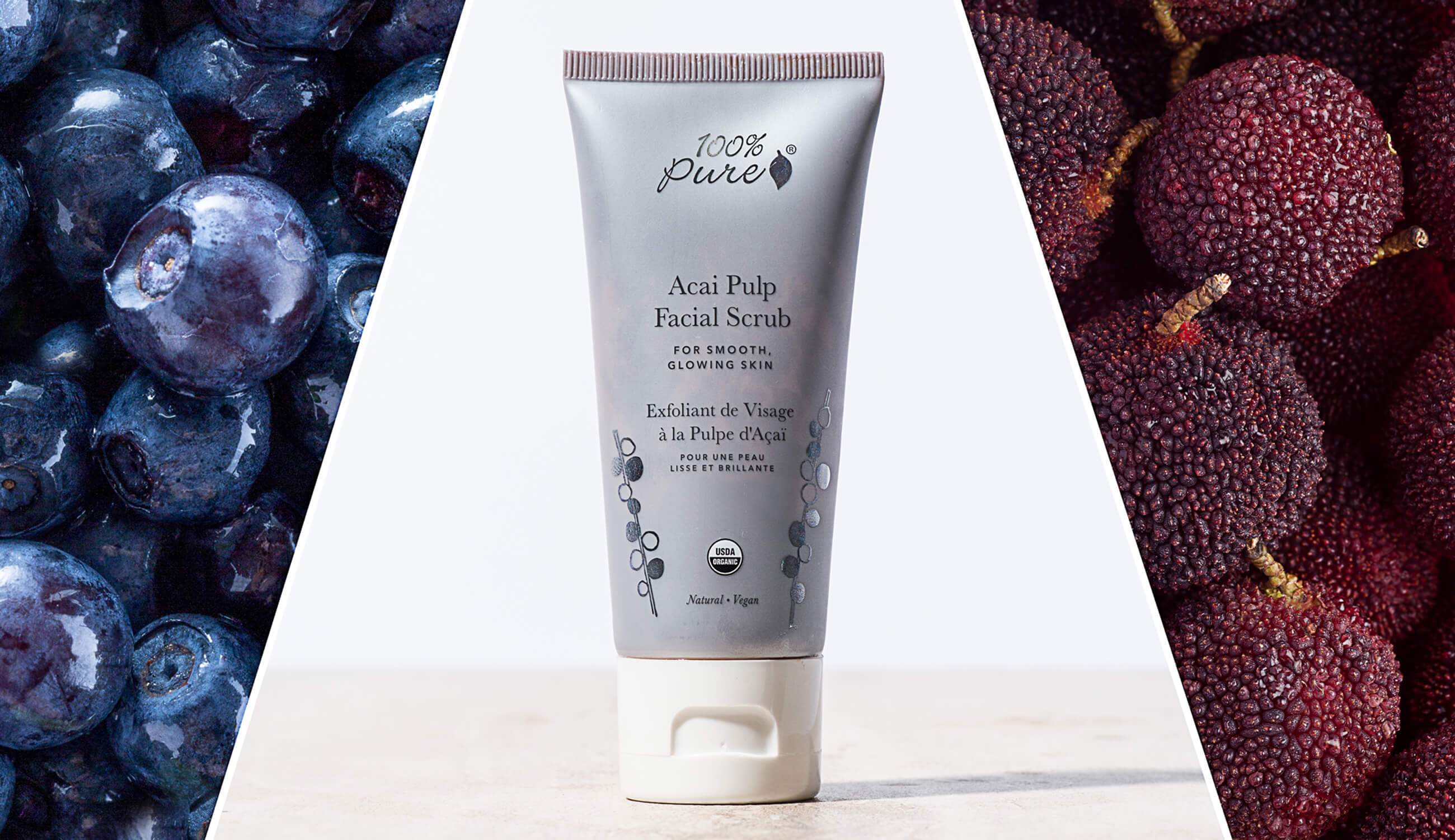
For many, a common skin care routine is as simple as cleanse, moisturize, and go! Often overlooked, exfoliation is an important step in a healthy skin care routine for all skin types.
We’re here to demystify this important skin care step, and guide you through exfoliation basics for every skin type and season.
When we created our award-winning Acai Pulp Facial Scrub, we were on a mission to formulate an organic exfoliating scrub that’s free of harmful chemicals and plastics. Free of artificial chemicals and detergents that are harmful to our bodies, and free of environmentally damaging exfoliating beads.
This intensive and concentrated scrub is full of antioxidant-rich super fruits, for fortifying skin against environmental and free radical damage. It keeps smog, exhaust, and environmental debris from wreaking havoc on your delicate skin.
When exfoliating your delicate facial skin, it’s important to use the right ingredients, and to avoid large-grained mechanical exfoliators. Rubbing large grains of sugar or salt into your skin can contribute to microtears and skin damage over time.
The Acai Pulp Scrub features finely ground grape seed and acai pulp, which are gentle enough for use even on sensitive skin. They pack plenty of buffing powder to slough away bumps, flakes, and dead layers while revealing fresh, more supple skin.
Alternatively, you can incorporate a powder cleanser into your skin care regimen over a full facial scrub. If you haven’t heard of these aqua-free products, powder cleansers are formulated and packaged as dry powders, which are activated when a liquid is added.
While they may take some getting used to how to exfoliate with them, powder cleansers are fantastic for a few reasons: the first being their gently exfoliating properties.
Since the granules are typically fine, soft, and plant-based, these cleansers are incredibly gentle on skin but will effectively slough away dead skin and banish excess oil. Another bonus is the customization factor: the more water you add, the less exfoliating it will be.
Try adding a micellar water to activate your exfoliating cleanser for more a gentler, more hydrating exfoliation. Try this with our Rose Micellar Cleansing Water, which contains organic botanical waters for a hydrating, toning effect.
Another plus: powder cleansers contain no preservatives! Because they are liquid-less, you can take them on a plane and you’ll never have to worry about it leaking all over your suitcase!
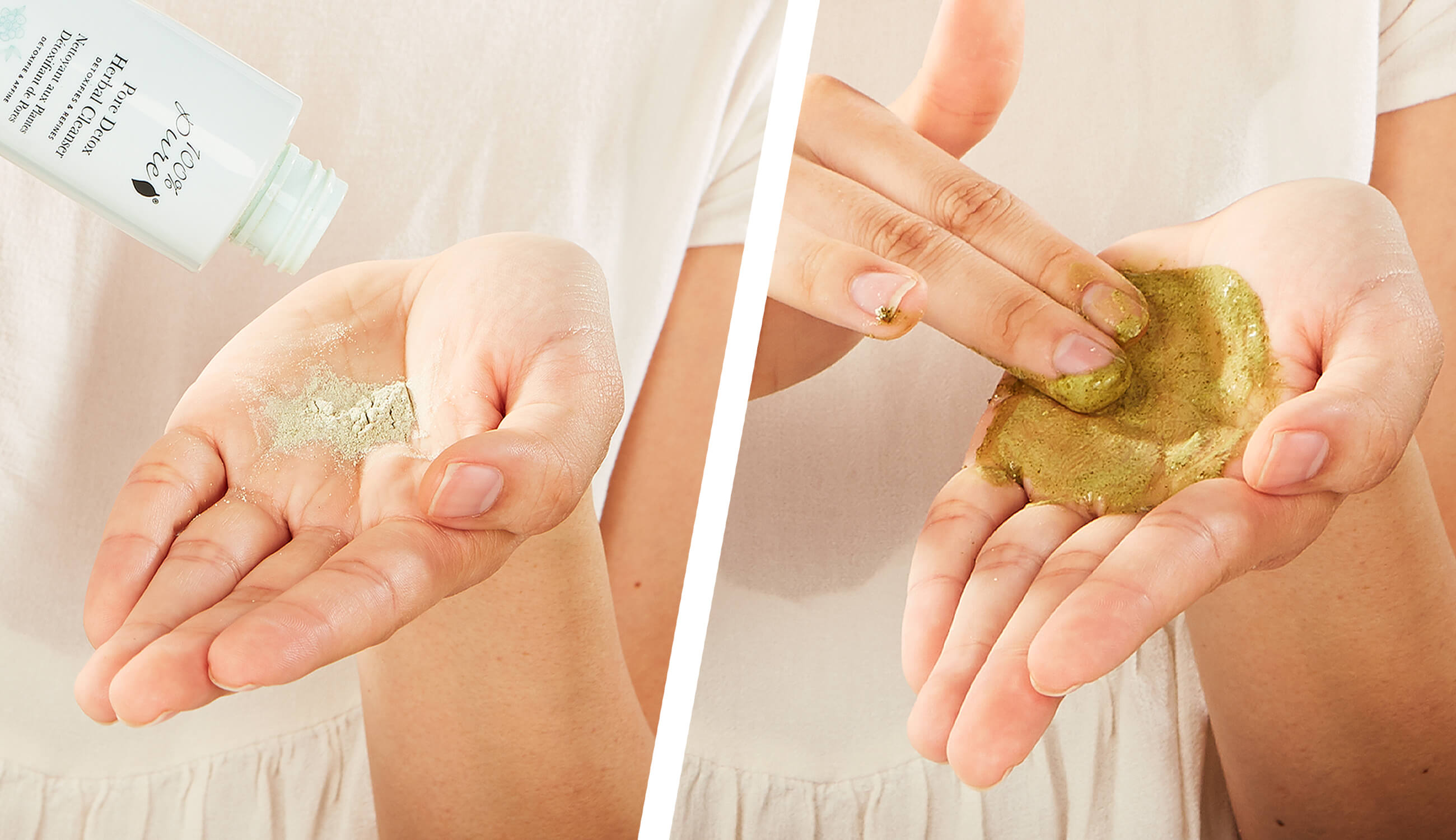
OILY / ACNE PRONE SKIN
When skin doesn’t shed fast enough, a buildup of dead skin cells can occur. This buildup can cover and clog the pores, causing sebum (your skin’s natural oil) to accumulate within each pore. As acne-causing bacteria feed on sebum, a buildup can lead to acne-causing bacteria reproducing at larger rates – resulting in even more breakouts.
Exfoliating helps to clear pores by removing the dead skin cells, dirt, and oil that can build up and create clogging complications. Generally, exfoliating your face 2-3 times a week would be beneficial for oily skin. Acne-prone skin can be more sensitive than other skin types, so when exfoliating, make sure to mix facial scrub with water on fingers before applying. Reduce to 1-2 times a week if skin seems to be more sensitive than usual.
If you need a cleanser that you can adapt to your need for exfoliation, we recommend our Pore Detox Herbal Cleanser. Thanks to detoxifying dandelion and neem, this cleanser will do the job of dissolving and uprooting sebum trapped in your pores, while green clay helps reduce excessive oiliness.
Since you can adjust its exfoliating properties by how much liquid you can add, this cleanser is the perfect treatment for varying types of acne. This cleanser also contains olive leaf oil and wheatgrass extract: antioxidant-rich ingredients that can reduce and prevent inflammation while protecting your skin from free radicals.
DRY SKIN
Exfoliation for dry skin should be less frequent, as the skin’s lipid barrier can be compromised by over-exfoliation.
For dry skin types flakes, bumps, and uneven patches are frustratingly common occurrences. Regularly exfoliating helps to clear flakes and bumps, resulting in skin that’s softer and more smooth to the touch. An added bonus is that makeup application will be much more manageable, since smoothed skin allows for a more even finish.
AGING SKIN
As we age, the average rate of skin cell turnover (the process that reveals fresh, younger layers of skin) slows down. Before the age of thirty, our skin normally sheds every 28 days. After the age of 30, that rate begins to slow and continues its descent with every passing year.
Exfoliating helps to speed up and increase skin cell turnover rate, boosting your skin’s circulation and healing process. By clearing away dead skin cells that cause dullness, exfoliation can also brighten your complexion to impart a healthy, youthful glow.
DULL / LACKLUSTER SKIN
Sloughing off dead skin cells helps to reveal the fresh, youthful skin waiting beneath. If you feel your complexion is a bit on the ‘blah’ side, exfoliation can perk your skin right up; using an organic facial scrub with brightening fruit extracts and citrus can certainly be an asset in this department!
IRRITABLE OR SENSITIVE SKIN
It’s no secret that our skin works hard to keep us healthy, but sometimes it becomes a little overworked – and irritable. Whether it’s exposure to harsh products, stress, or an allergic reaction, skin can often be left overstimulated and hypersensitive.
If your skin is irritated or irritable, try a gentle, soothing product like our Lavender Oat Milk Soothing Cleanser. This powder formula is only as exfoliating as you want it to be, based on how much liquid you use to activate it. It’s also formulated with colloidal oatmeal, which is incredibly nourishing to even the most irritated skin.
Delicate botanicals like rose, which makes it especially moisturizing, and lavender. Lavender is an iconically soothing ingredient: one study showed that the terpenes which give lavender its scent make it a powerful natural stress-relief. Not to mention that it can fight acne and reduce scars!
This cleanser is especially wonderful for those with irritable skin. It contains zero harsh detergents and foaming agents (like sodium laureth sulfate), and doesn’t leave your skin feeling stripped.
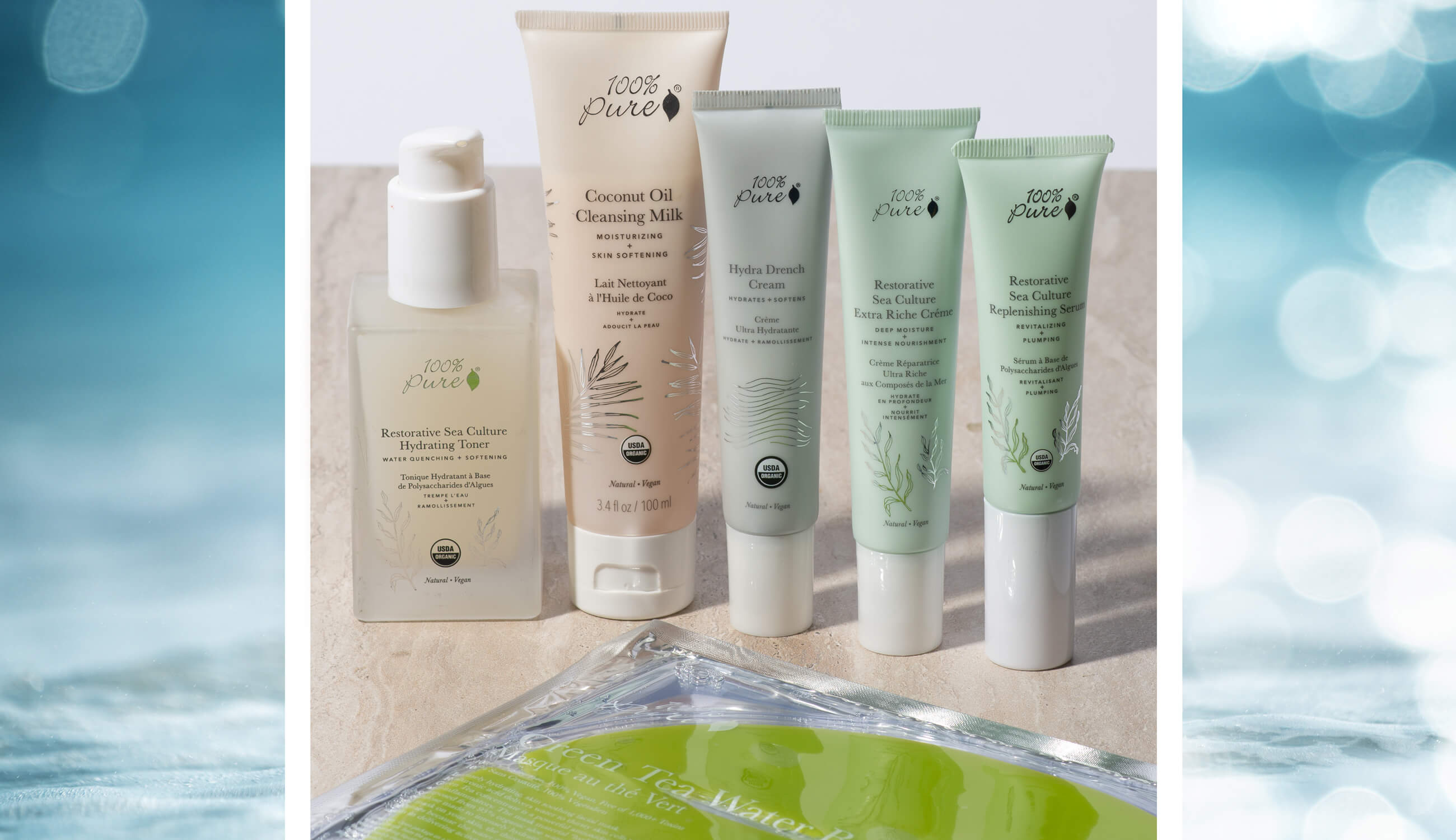
You may already know how to exfoliate your skin properly, but knowing how to execute your aftercare is just as important. Especially after exfoliating, it’s important to be gentle with your skin while thoroughly protecting it from the elements.
First, carefully check your daily skin products for additional exfoliating ingredients. If any of your daily products feature chemical exfoliants like citric acid, salicylic acid, or lactic acid, you should avoid using them for a few days after you’ve used your scrub. Too many courses of mechanical and chemical exfoliation can result in unpleasant skin irritation and inflammation.
You should also make sure to steer clear from products that contain harmful denatured alcohol. These ingredients can dry your skin and damage it at the cellular level. Applying them to your skin right after exfoliating will allow them to penetrate even deeper into the tissue.
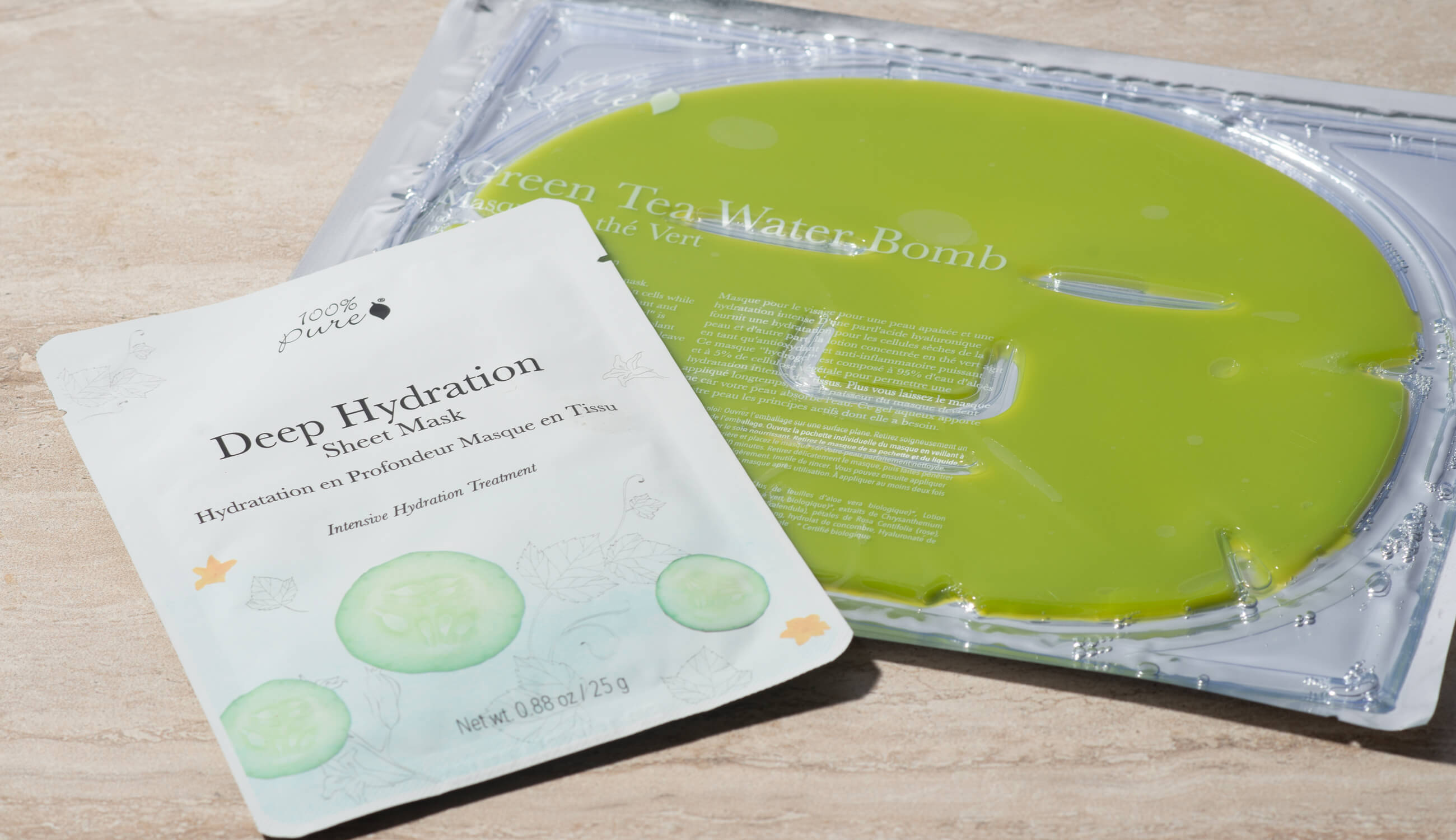
The best way to care for your skin after exfoliating is by applying light products that will deliver deep hydration. We love our Deep Hydration Sheet Masks, which deliver a powerful dose of hydration and plumped, supple-looking skin.
Our Restorative Sea Culture Hydrating Toner is another great hydrator, packed with refreshing marine nutrients to soften and brighten your skin. It’ll help your skin to recover from the exfoliation process looking smoother and brighter than before.
STEP #1
Start with a cleanser that’s right for your skin type. We chose the gentle and moisturizing Argan Oil Creamy Cleanser, which works for all skin types. Take your time when massaging this cleanser into your skin to increase blood flow and circulation.
STEP #2
Next, use the Acai Pulp Facial Scrub for a full exfoliation. This scrub uses 2 sizes of grape seeds for amazing exfoliation results. The larger seeds buff away flakes and bumps, and the small seeds polish the skin, making it feel supple and soft.
Emulsify a quarter sized amount onto your fingers with water, and apply to wet skin. When applying any facial scrub, take care to massage the product gently into skin using upward circular motions for up to 2 minutes. Rubbing a facial scrub too vigorously – or for too long – can cause irritation and damage to the skin.
STEP #3
Now that you’ve exfoliated your skin, it’s time to reap the next phase of benefits from exfoliation: better product absorption! Right after exfoliating, we recommend following up with a nutrient-packed toner. The Restorative Sea Culture Toner replenishes hydration, while reducing inflammation with calming, alcohol-free witch hazel.
STEP #4
The next step is to apply nourishing serums that can deeply penetrate your freshly exfoliated skin. The Restorative Sea Culture Replenishing Serum is ideal for enhanced hydration and nourishment after exfoliation.
STEP #5
After exfoliation, applying an occlusive product like a moisturizer will help to protect delicate, newly resurfaced skin. We use the Restorative Sea Culture Extra Riche Créme for deep, water locking moisture from bacuri butter, shea butter, coconut oil, and jojoba oil.
DO
-
Exfoliate at night, and make sure to use SPF during the day. The fresh skin that’s been revealed is delicate, and needs to be pampered and protected. It can also be more sensitive to sunlight, and using a natural sunscreen will protect it from sun damage.
-
Exfoliate 1-3 times a week depending on skin type. Once a week is recommended for those with sensitive skin types, and for more oily skin types, 3 times a week is recommended. Gauge how your skin feels, and add in more or less exfoliation as needed.
-
Exfoliate your body, not just your face; properly exfoliating your body can buff away dry skin and prime skin for maximum absorption of products to follow. Dry brush your skin with a bath sponge or body brush, to remove already loose dead skin.
When adding your natural body scrub to wet skin, always be sure to gently massage into skin using circular motions to increase circulation and get an even exfoliation. Follow with an ultra skin softening, nourishing body cream or body butter in your signature scent to restore hydration and moisture to freshly exfoliated, delicate skin.
DON'T
-
Don’t over-exfoliate – it can cause damage to the skin’s lipid barrier. Exfoliating too frequently can cause damage to the skin itself, but can also cause increased dryness and sensitivity. Gentle exfoliation on a spaced apart schedule is key.
-
Don’t exfoliate damaged skin! If you have sunburnt or hypersensitive skin, or open acne lesions on your face, exfoliation can make damaged skin issues worse.
-
Don’t use plastic exfoliant beads! These beads have been banned since July of 2017, however there are still brands selling products that contain them, so you’ll have to carefully read product labels. These plastic beads go down the drain and end up in our ocean, wreaking havoc on both plant and animal marine life.
-
Don’t use salt or sugar scrubs! They may prove too harsh for delicate skin of your face; save these for rougher parts of your body like elbows, knees, and anywhere else you have a tough buildup of dead or dry skin. Any scrub that’s too abrasive can cause micro tears in the skin. Ground apricot pits are more eco-friendly than plastic beads, but are another big culprit to micro tears and they should be avoided.
During fall and winter, it’s normal to be tempted to up your exfoliating game, as the cold air outside and the dry warm air indoors can create more dryness in the skin. Just make sure to follow up with ample hydrating and moisturizing products.
There can be more moisture in the air during spring, and depending on where you live, summer can be quite humid. You can lessen your exfoliation depending on your skin type. For example, if you’re experiencing a blemish flare-up, this may be a good time to up your exfoliation, to clear dead skin buildup in pores and keep debris from sticking to skin due to increased moisture in the air.
Not to be forgotten, exfoliation is a super important part of your skin care routine, no matter your skin type! Following these basic guidelines will lead to rejuvenated, brighter, and potentially clearer skin. Sound good? We think so too.
- Tags: December-2019, how-to, Skin Care
We carefully hand-select products based on strict purity standards, and only recommend products we feel meet this criteria. 100% PURE™ may earn a small commission for products purchased through affiliate links.
The information in this article is for educational use, and not intended to substitute professional medical advice, diagnosis, or treatment and should not be used as such.


